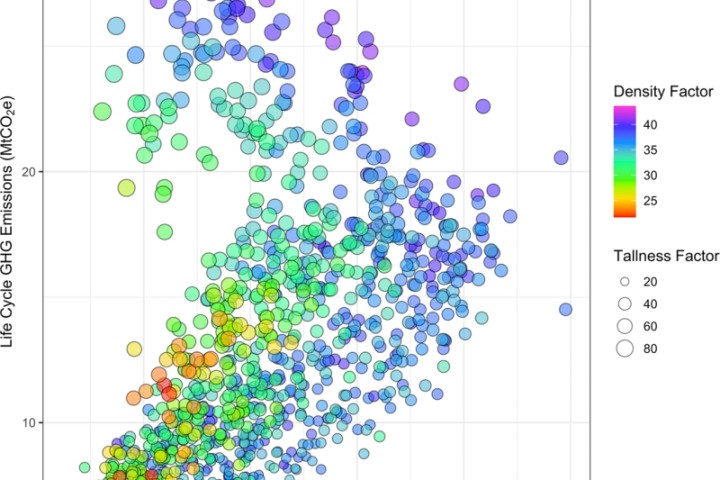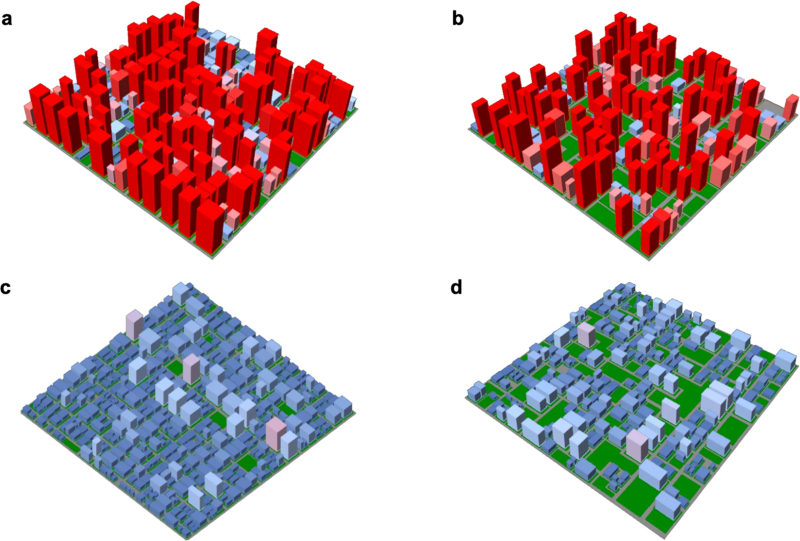Study finds high-density, low-rise cities such as Paris may be optimal urban form for reducing life cycle GHG emissions

(LCGE) versus number of people accommodated for a fixed land area. Pomponi et al.
There is a growing belief that building taller and denser is better. However, urban environmental design often neglects life cycle GHG emissions. Here we offer a method that decouples density and tallness in urban environments and allows each to be analysed individually. We test this method on case studies of real neighbourhoods and show that taller urban environments significantly increase life cycle GHG emissions (+154%) and low-density urban environments significantly increase land use (+142%). However, increasing urban density without increasing urban height reduces life cycle GHG emissions while maximising the population capacity. These results contend the claim that building taller is the most efficient way to meet growing demand for urban space and instead show that denser urban environments do not significantly increase life cycle GHG emissions and require less land.
—Pomponi et al.
The work, recently published as an open-access paper in npj Urban Sustainability, contributes to a growing debate around the design of future urban environments. The built environment is a big contributor to carbon emissions, global energy demand, resource consumption and waste generation. In the US, it accounts for 39% of all greenhouse gases emissions, while in the European Union, it accounts for 50% of all extracted materials and 42% of the final energy consumption.
Jay Arehart, an author on the paper and instructor in the Department of Civil, Environmental and Architectural Engineering at CU Boulder, said the work challenges current conventional understanding that tomorrow’s cities must be densely packed and stretch upwards to address and curb greenhouse gas emissions. The idea being that tall buildings make optimal use of space, reduce operational energy use for heating and cooling and enable more people to be accommodated per square meter of land.
Both the urban sprawl that we see in the suburbs of the United States and the high-rise that we see in places like New York City are not necessarily optimal. We showed that new development should focus on minimizing whole-life carbon of buildings, not just the emissions from their operations or their materials. That density is needed for a growing urban population, but height isn’t.
—Jay Arehart
The team investigated four different urban typologies:
-
High density, high-rise (HDHR) (e.g., Manhattan);
- Low density, high-rise (LDHR) (e.g., Le Corbusier “Radiant City”);
- High density, low-rise (HDLR) (e.g., Central Paris); and
- Low density, low-rise (LDLR) (e.g., suburbs).

a HDHR, b LDHR, c HDLR, d LDLR. Pomponi et al.
The researchers simulated 5,000 environments based on real-world data to establish their lifecycle greenhouse gas emissions. This approach considered both premium for land (the extra land needed to build low-rise compared to high-rise) and premium for height (the extra materials to build high-rise compared to low-rise) to make comparisons fair, said Francesco Pomponi, the lead author on the paper and professor at Edinburgh Napier University.
We developed a novel urban density metric to measure things up as accurately as possible. Our results show that density is indeed needed for a growing urban population, but height isn’t. So it seems the world needs more Parises and fewer Manhattans—as much as I love New York—in the next decades.
—Francesco Pomponi
Urban Sustainability is the newest addition to the Nature Partner Journals series.
Resources
- Pomponi, F., Saint, R., Arehart, J.H. et al. (2021) “Decoupling density from tallness in analysing the life cycle greenhouse gas emissions of cities.” npj Urban Sustain 1, 33 doi: 10.1038/s42949-021-00034-w

_0.jpg)